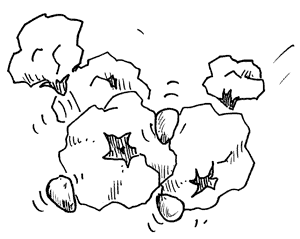STRANGE BUT TRUE- Pericarp-ing: Tough shell yields bigger pop

Q. What does popcorn science have to say about why popcorn pops? –O. Redenbacher
A. Plenty. Picture each kernel as a tiny pressure cooker where the water trapped inside vaporizes and turns the starchy guts into a molten mass, says Joshua Foer in Discover magazine. When a kernel explodes, the tough outer shell (pericarp) shatters, and the gelatinous starch instantaneously solidifies.
Brazilian scientists recently established that a popcorn pericarp is four times stronger than that of regular corn, allowing for higher pressure and a bigger pop, hence bigger flakes. Vacuum poppers raise the pressure differential further, making for a "monster" pop!
The science may be new, but the snack sure isn't. Popcorn took off in the U.S. in the early 19th century. Then in 1948, a team of archaeologists discovered a 4000-year-old cob of popcorn in a New Mexico cave. "Remarkably, the kernels still popped," Foer says.
Q. When it comes to romantic love, what is our most important body part? Woody Allen once joked this was his "second favorite organ." -R. Hingeley
A. Don't laugh, it's our 3-pound brain, says anthropologist Helen Fisher in Why We Love. Fully one- third of our 33,000 human genes are devoted to brain functions. With our huge prefrontal cortex and its "combinatorial explosion" of connections, we assemble facts, solve problems, weigh options, make decisions, plan ahead.
We also add meaning and emotional value to our thoughts. This is the brain region that lends us almost infinite capacity to think about "him" or "her" and to feel keen pleasures as well as fears, rage, aversion. Our remarkable storage bin hippocampus enables us to remember our beloved in exquisite detail of facts and feelings. Maybe most important is the caudate nucleus– for focused attention and intense motivation to win rewards– spurring us into action with just a single lovesick gaze. At some point, all of this jelled into a sort of primitive animal magnetism.
By 35,000 years ago, our ancestors' brains had taken our modern shape, so that we have somehow emerged with special talents of wit, a charitable spirit, and many other courting traits, including the astonishing human ability to fall "head-over-heels in love."
Q. What's it take for a horse-borne cavalry regiment to capture an entire fleet of ships at sea? Without firing a shot, one might add. –N. Bonaparte
A. It had to be one of the strangest "battles" in human history, as discussed by Roger Bentley in the Quarterly Journal of the Royal Meteorological Society, says Randy Cerveny in Freaks of the Storm. It was during the Napoleonic Wars of the late 18th century, when the bitter cold of the Little Ice Age (1500-1850) made military movements difficult. And more than difficult: A winter blast completely entrapped the Dutch navy in thick ice around Texel Island near the coast; 15 ships, 2 cargo vessels, and several smaller cannon boats were solidly frozen in the ice.
When the French general heard the news, he immediately dispatched a 128-man force across the frozen tidal flats, right up to the ice-locked ships, and demanded surrender. Realizing the hopelessness of the situation, the Dutch admiral calmly replied, "Why don't we discuss such serious matters over dinner aboard my flagship?" "And so it happened," says Cerveny, "that a cavalry regiment captured a battle fleet at sea– admittedly a frozen sea– without any loss of life."
Q. What puts the laugh in "laughing gas"? –L.B. Dickens
A. That's "nitrous oxide" (N2O) to dentists who administer the inhalant analgesic (and weak anesthetic) to patients to control pain and anxiety, says University of Maryland Baltimore County behavioral neuroscientist Robert R. Provine in Laughter: A Scientific Investigation.
Discovered in 1772 by Joseph Priestly (discoverer of oxygen), the gas caught on as a recreational drug among the likes of poets Samuel Taylor Coleridge and Robert Southey, and soon laughing-gas shows were staged. At one of these in 1844, dentist Horace Wells observed that an intoxicated fellow did not flinch at what should have been a painful accident– and painless dentistry was born.
Even today, says Provine, N2O's laugh production is not well understood. It is clearly not a magic bullet to a laugh brain center, as laughter is not reliably induced– and when it is, it's not of the uncontrollable ha-ha-ha variety. It's more a social or contagious laugh, lying as much in psychology (disinhibition) as pharmacology.
Or as the guy who introduced Wells to the stuff put it, "Its effect is to make people laugh, sing, dance, speak or fight, etc., according to the leading trait of their character."
A lot like a bunch of drunks at a party.
Send Strange questions to brothers Bill and Rich at [email protected].
#